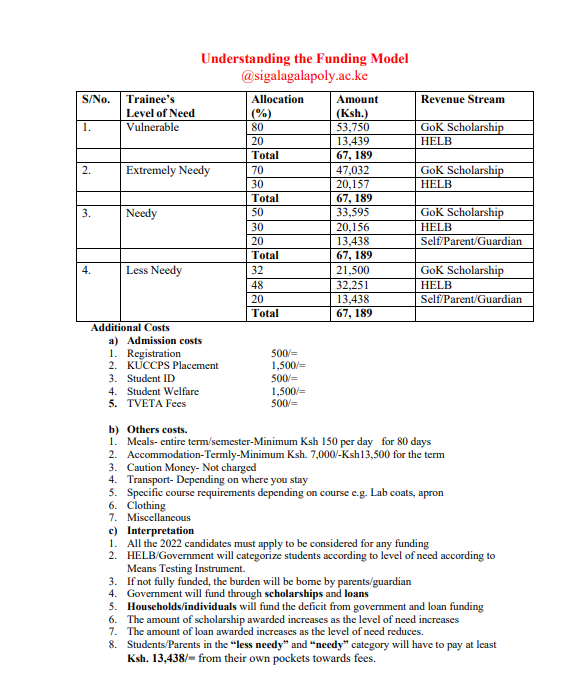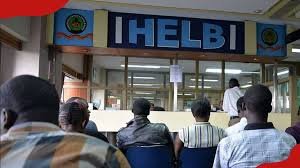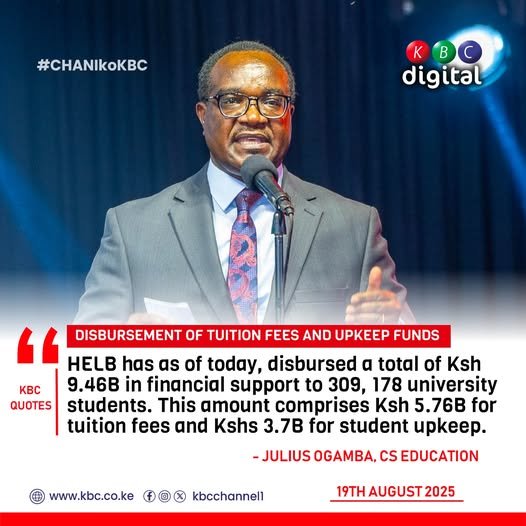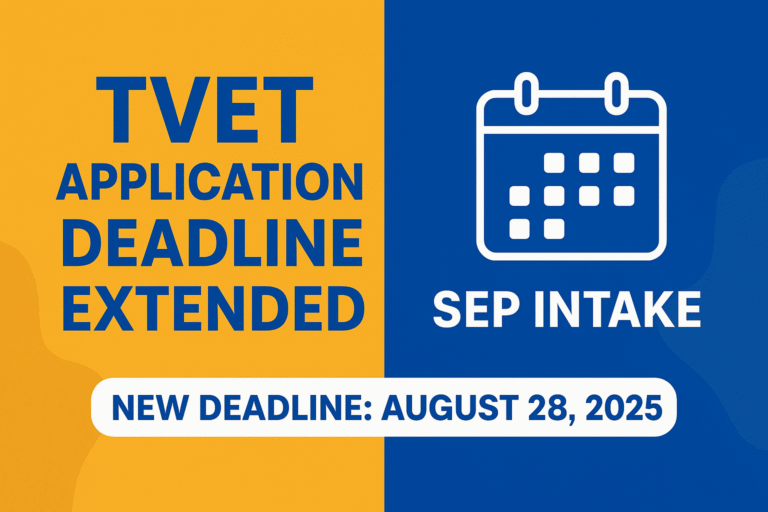The Higher Education Loans Board (HELB) has officially introduced a new loan allocation model that replaces the old band-based system used in previous years. This move comes after the government’s decision to scrap the former funding structure and replace it with a more transparent, data-driven method.
Under the new model, HELB will allocate student loans based on two main factors:
- The actual cost of the academic programme a student is pursuing
- The student’s financial need, assessed using the Means Testing Instrument (MTI)

Unlike the old method where students were grouped into funding bands (A, B, C), every student will now receive a personalized loan amount, depending on:
- The fee structure of their course (as provided by their university or college)
- Their household economic background, analyzed through MTI using various indicators like income, family size, and location.
This new structure also affects upkeep loans, which will now vary for each student. HELB clarified that first-year students will receive different upkeep loan amounts, based entirely on their individual financial need and the reduced cost of programmes.
The changes follow a recent government disbursement of Ksh 9.4 billion to support over 309,000 university students for the 2025/2026 academic year. Of this, Ksh 5.7 billion was allocated to tuition, with the remaining funds set aside for student upkeep.
In short, the updated HELB loan allocation system is designed to ensure fairness, equity, and financial sustainability, so that the most vulnerable students get the most support, and funding is properly aligned with real programme costs.
What Changed in the HELB Loan System?
Previously, HELB gave student loans using a system called the “band method.” This means students were placed in Band A, B, or C, and each band got a fixed amount of loan same for everyone in that group, no matter their background or course.
But this method wasn’t fair.
- A poor student studying an expensive course could get less money than needed
- A wealthier student studying a cheap course could get more money than necessary
To solve this, HELB has removed the band system and introduced a new model that is based on actual need and course cost.
What the New HELB Loan Model Is
The new HELB loan model is a system introduced to make student funding in Kenya fairer, smarter, and more targeted. Instead of giving the same amount to students in fixed groups (bands), HELB now gives loans based on two key things:

✅ 1. Your Financial Need
HELB checks how much support you really need using a tool called the Means Testing Instrument (MTI). It looks at your family income, home location, number of dependents, and more.
✅ 2. The Actual Cost of Your Course
Different courses cost different amounts. For example, Medicine and Engineering are more expensive than Arts. HELB now adjusts your loan based on what your course really costs.
This new model helps make sure that:
- Poorer students get more support
- Students in expensive programmes get enough funding
- No money is wasted on students who don’t truly need it
It’s a personalized, data based approach to make higher education more accessible for everyone in Kenya.
Difference Between Old and New HELB Loan Models
| Feature | Old Model (Band System) | New Model (Need-Based System) |
| Loan Allocation Method | Based on Bands (A, B, C) | Based on student’s financial need and course cost |
| Loan Amount | Fixed amount for each band | Personalized amount for every student |
| Upkeep Loan | Same amount for all students | Varies based on student’s need (MTI score) |
| Course Cost Consideration | Course cost not considered | Course cost is a major factor in allocation |
| Assessment Tool | No detailed financial background check | Uses Means Testing Instrument (MTI) to assess financial need |
| Fairness | Some students got too much or too little | Targets those who need help the most |
| Efficiency | Easy to process but not accurate | More accurate and data-driven |
| Purpose | Simple loan distribution | Ensure fairness, equity, and proper support |
Key Highlights
- The Higher Education Loans Board (HELB) has introduced a new loan system for students.
It has removed the old band-based model (Band A, B, C) that used to group students into fixed loan categories. - Under the new model, loans will now be given based on:
- The actual cost of the course you’re studying
- Your financial need, which is how much help you truly require
- The actual cost of the course you’re studying
- HELB will not use bands anymore. Instead, every student’s situation will be checked individually to decide how much loan they should receive.
- The cost of your course will be collected by HELB directly from your college or university through real-time data.
This ensures the loan matches the true price of your academic program. - HELB will use a tool called the Means Testing Instrument (MTI) to check your financial background.
This scientific method looks at things like:
- How much your parents or guardians earn
- Where you live
- How many people are in your household
- And other related details
- How much your parents or guardians earn
- The Kenyan government has released Ksh 9.4 billion to help 309,178 university students.
- Out of this, Ksh 5.7 billion has been used to pay tuition fees
- The remaining amount is for upkeep support (like food, rent, books, and transport)
- Out of this, Ksh 5.7 billion has been used to pay tuition fees
- Some students have received lower upkeep loans this year.
HELB explained this happened because the government reduced the cost of some university programs, so students now need less money for those courses.
Breakdown of Government Disbursement
To support the new funding framework, the government has already released Ksh 9.46 billion for the 2025/2026 academic year. This includes:
- Ksh 5.7 billion for university tuition fees
- The remaining Ksh 3.76 billion allocated to student upkeep
Over 309,178 university students have benefited from this disbursement so far, with additional support extended to TVET students.
Why Some Students Received Lower Upkeep Loans
One of the most common questions among students is:

“Why is my upkeep loan lower this year?”
HELB has clarified:
- The cost of many university programmes has been reduced by the government.
- As a result, the loan amount has been adjusted downward to match the new, lower costs.
- The MTI may also assess that a student’s household is capable of covering part of their living expenses.
So, lower cost = lower need = lower loan, based on transparent, data-driven calculations.
Who Benefits the Most?
This model is especially beneficial to:
- Students from low-income families
- Learners enrolled in expensive programmes
- Students in rural or marginalized regions
- Orphans and single-parent families
- Those studying in HELB-accredited universities and TVET institutions
It ensures that funds are not wasted on students who don’t truly need them and are instead focused on those who do.
HELB Official Statement
“Each student’s allocation is based on their assessed level of financial need and the cost of the programme. The new model replaces the band system to ensure that financial aid reaches those who need it the most.”
HELB Announcement, August 22, 2025
What is the new HELB loan model?
The new HELB loan model replaces the old band system and is now based on two main factors: the actual cost of your academic program and your financial need. Instead of giving all students in one group the same amount, HELB now gives each student a customized loan depending on how much their course costs and how much help they need financially. This makes the system more fair and accurate.
What is the Means Testing Instrument (MTI)?
MTI stands for Means Testing Instrument, which is a scientific method HELB uses to check your financial background. It looks at your parent or guardian’s income, their employment status, the size of your household, the type of school you went to, and your home location. This helps HELB understand your situation and decide how much loan you should receive based on your real financial need.
How does HELB know the cost of my course?
HELB collects real-time data directly from universities and colleges to find out how much each program actually costs. This includes tuition, materials, and other learning expenses. By using this data, HELB makes sure students in expensive courses like medicine or engineering get enough financial support, while those in lower-cost courses get just what they need.
Will all students get the same upkeep loan?
No, upkeep loans are now different for every student. Under the new model, HELB uses your MTI score and the cost of your program to decide how much upkeep support you need. This means students from low-income families or those facing more challenges will receive higher upkeep loans compared to others. There’s no fixed amount anymore.
Why did some students receive lower upkeep money?
Some students received a lower upkeep loan this year because the government reduced the cost of many university programs. As a result, students now need less funding for certain courses. Also, if the MTI tool shows that a student’s family can afford basic living costs, they may get a smaller loan. The system is designed to provide the right support to those who need it most.
Who benefits the most from this new HELB model?
The new model is especially helpful for students from low-income households, those taking expensive courses like medicine, students living in rural or marginalized areas, and orphans or children from single-parent families. It ensures that limited government funds go to the people who truly need them the most.
Conclusion
The new HELB loan allocation model marks a significant shift in how higher education funding is handled in Kenya. By moving away from the outdated band-based system and adopting a need-based, data-driven approach, HELB aims to ensure that every student receives support that matches their actual circumstances.
Whether it’s the cost of their course or their family’s financial background, the new model prioritizes fairness and transparency. With personalized loan amounts and targeted upkeep support, the system is now better equipped to help the students who need it most making higher education more accessible and sustainable for all.




